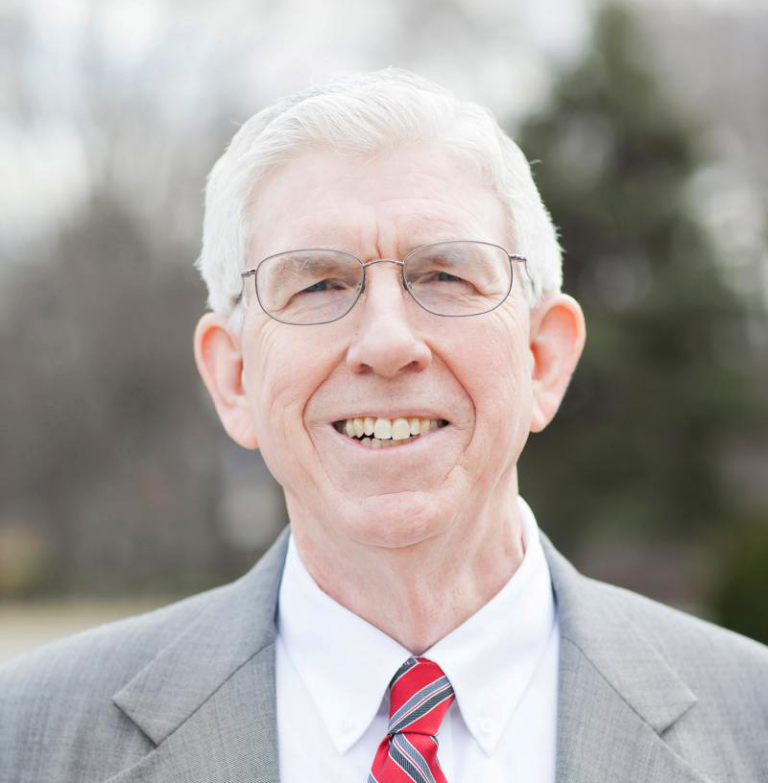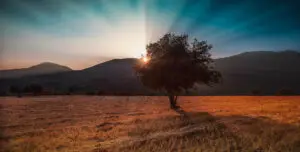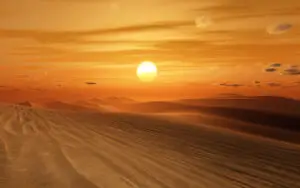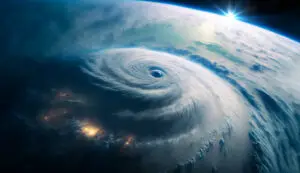Genesis 1:1–2:3
Genesis 1 and 2 narrate a straightforward account of what God did in the creation of this earth as the most important place in the entire created order, and man as the most important created being among all things created. Why this is so is unfolded subsequently in the ongoing revelation as God’s purpose is laid out layer by layer, point by point, until the finale of the new Heavens and the New Earth in the final book of God’s written revelation. Although it is not wise to speculate what God was doing before he created the world, we should with gratitude receive the knowledge that he willingly gives us of his pre-creation plans and decrees; it is a sinful negligence of stewardship to avoid them. Psalm 90 gives a powerful and glorious picture of the immutability of God and his perfect and joyous existence prior to the creation of the world. In the revelation he had of God Moses said, “Before the mountains were brought forth, or ever you had formed the earth and the world, even from everlasting to everlasting, you are God” (Psalm 90:2 NKJV). In our fallen and cursed condition the only hope for gladness and joy rests in the eternal joy of God: “Satisfy us in the morning with your steadfast love, that we may rejoice and be glad all our days” (Psalm 90:14 ESV) We know that before the foundation of the world, the Father loved the Son: “Because you loved me before the foundation of the world” (John 17:24). We know that he chose a people to be given to his Son before the foundation of the world: “Even as he chose us in him before the foundation of the world . . . In love he predestined us for adoption through Jesus Christ, according to the purpose of his will” (Ephesians 1:4, 5 ESV). We know that Christ as Messiah was “foreknown before the foundation of the world” (1 Peter 1:20) and that this messiahship included his redemptive death, as the “Lamb slain” had a book in which the names of those that the Father had given him were written “before the foundation of the world” (Revelation 13:8; John 17:2, 19). We thus get the idea that God created the world as the arena in which his love for the Son would be demonstrated by making him the “firstborn among many brothers” (Romans 8:29).
Ideas to note:
- There is a pattern of creation and distinction in the progress of the narrative.
- There is some evidence that each stage of creation represents an increase of the manifestation of the glory of God—from the initial manifestation of lifeless and structureless matter to beings made in the image of God.
- Each stage of extension of creation, when finished, is called “good.” Good involves moral goodness considering its source and its purpose, but also beauty and utility. All things were designed to be useful to man when he would be created and would increase the sense of gratitude to God as the source of all things and worship as they continually witness to the beauty of his goodness and holiness. Man is superior to all other things in creation and is called “very good.”
- Because of the repetition of the phrase “evening and morning” and the statement in 2:3 (“So God blessed the seventh day and made it holy”), there is no reason to view these days in any other form than what we presently experience as days including evening and morning.
I. Days one through three
A. On day one, God spoke into being the universe, darkness, and light.
-
- Moses reported a fiat [L – ‘let it be done’] ex nihilo [L ‘out of nothing’] call-into-being of the heavens and the earth.
-
-
- There is an uncreated heaven, the presence of the manifestation of uncreated light that constitutes the glory of the triune God, “who alone hath immortality, dwelling in the light which no man can approach unto; whom no man hath seen, nor can see; to whom be honor and power everlasting. Amen” (1 Timothy 6:16). It is to this uncreated heaven that the Psalmist referred when he wrote, “O Lord, our Lord, how excellent is thy name in all the earth! Who hast set they glory above the heavens” (Psalm 8:1).
- The word heavens in this account denotes the created space, virtually infinite, beyond the surface of the earth. This account, therefore, is highly geocentric.
- Created material reality is divided into two areas of activity—the heavens, which declare the glory of God (Psalm 19:1), and the most important area in which God’s purpose in creation will be acted out, the earth. We should not be fooled by skeptical philosophies and false deductions from science that the earth is relatively unimportant, given the size of the cosmos, and highly fragile, given the massive unlikehood of all the conditions arising which would give rise to and support life. This sphere is the place from which God will manifest his infinite glory in and to all created things (Philippians 2:10, 11). Psalm 104:5 says that God “laid the foundations of the earth, that it should not be removed for ever.” “Forever” in this case means that it will stand as long as God has ordained to work his purpose of redemption, until it is replaced by the new earth. “But the heavens and the earth, which are now, by the same word are kept in store, reserved unto fire against the day of judgment and perdition of ungodly men” (2 Peter 3:7).
-
-
- “Darkness was over the face of the deep” – In this first instance of creation, there was no division of land from water, no shapes that appeared on the earth and there was no light. Prior to the existence of the heavens and the earth as created entities, there was no darkness. Only God existed, and “God is light and in him there is no darkness at all” (1 John 1:5). With the existence of space and matter, darkness is its natural state without created light. Although Paul wrote about spiritual darkness and light, his analogy borrows from the physical reality: “But when anything is exposed by the light, it becomes visible, for anything that becomes visible is light” (Ephesians 5:13, 14).
- The Spirit of God was hovering – The dynamic operation of the Spirit sustained the existence of that that was created. His hovering constituted an ongoing creative power maintaining all the powers present within the fecund energy of this “dark matter.”
- The creation of light – Light is created as an entity separate from the bodies that eventually are constituted by it or reflective of it.
-
-
- Though God has established an order of operation according to secondary means, all things are none-the-less dependent immediately on him for their existence and their continued existence.
- Moses never would have fabricated such an order from his own observation and learning. He knew that day and night as commonly and universally observed correspond to the relation of earth to the sun. He had his formal learning from the Egyptians who saw themselves as so dependent on the sun that they looked upon it as a god. One of the plagues that came upon the Egyptians was a three day darkness that could be felt so that “they saw not one another, neither rose any from his place for three days” (Exodus 10:21, 22).
- The order here is a clear indication of special revelation, not human observation or the inscripturation of any ancient superstition.
- This establishes divine sovereignty in the purpose of creation.
-
-
- The separation of the light from the darkness – God also established day and night before the creation of the sun and moon by gathering the light into a location so that both light and darkness were present. Psalm 104:2 gives a poetic presentation of this isolation of light by divine power, “covering yourself with light as with a garment.”
B. Day Two involved the division of waters into clouds and vapor on the one hand and the seas that at this time still covered the entire surface of the sphere of the earth.
Again, Psalm 104 seems to be a delightful poetic reflection on the creation that follows roughly the order of Genesis 1. Verse 6 says, concerning the earth, “You covered it with the deep as with a garment; the waters stood above the mountains.” Evidently the waters were in two forms, the coherent body of water with a heavy mist hovering, like the Spirit above the surface of the water. God raised the mist, put an expanse, or sky, between the earth-bound waters and the mist. “He lays the beams of his upper chambers on the waters; he makes the clouds his chariot” (Psalm 104:3).
C. Day Three – The water on the earth is separated from the solid material suspended in it, and vegetation is caused to grow on the land.
-
- Psalm 104 goes on the say, in verse 7, “At thy rebuke they fled; at the voice of thy thunder they hasted away.” From what appeared as simply an aqueous globe, now there is a division between the water and the land, and the land apparently immediately is dry. One may think of God’s separation of the Red Sea from its earthen floor that immediately was dry for the safe movement of the Israelites from the oncoming slaughter intended by the Egyptian army. Since this already has occurred at creation, none should think it strange that God could, and did, do the same thing in the forming of his messianic nation.
- During the flood that destroyed the earth, the waters returned to their original position of covering all. Except for that occasion of destruction, God has “set a bound that they may not pass over; that they turn not again to cover the earth” (Psalm 104:9).
- With the appearance of dry land, God immediately caused it to bring forth all plant life. It seems that this productiveness was embedded within the soil from the initial moment of creation for at God’s command, “the earth brought forth.” Not only was the appearance of these first plants in all their variety, but the means of their being multiplied and perpetuated was also present.
II. Days Four through Six
A. Day Four – God made the bodies from which the pre-existent light—from day one—would proceed or from which it would be reflected.
-
- This is a condescension to our weakness and to our need to find form and order and build our lives on observation of cause and effect relationships. God could have continued the world with its rhythm of day and night and seasons etc. by immediate power, but for our observation, investigation, reflection on issues of consistency, rationality, and cause and effect he has established organic connections within the created order. As humans accumulate their grasp of the created order with the relationships established by God, this should lead us to see that all things, because they have such indivisible interaction, proceed from one purposeful, infinitely intelligent being. The fittedness of all things for each individual thing, and the teleological connections of various things within their smaller spheres of existence show that the entire cosmos proceeds from purpose.
- Jesus showed his immediate power over his creation in saying, “Peace, be still,” (Mark 4:39) so that even the winds and the waves obey him. He bypassed the roots, vine, and grape in making wine directly from water (John 2:7–9). So it is with his healings of leprosy, raising the dead, giving sight to one born blind, etc. His bypassing of second causes, in fact, his fiat reversal of the effects of causes demonstrates that he is God and that “he upholds all things by the word of his power” (Hebrews 1:3) and that “He is before all things and by him all things consist” (Colossians 1:17).
- The light bearing bodies, therefore, seem to have been made by God’s gathering of the light previously created and concentrating it in the sun and other suns throughout the universe so that their constituent composition is light. Any effect is the sum total of its causes. God has begun with what we observe as an effect (light) and concentrated it into many individual spheres (suns) so that the cause is the mere concentration of its effect.
- All of these bodies in the heaven have such an inter-relation that they also, by God’s wisdom, govern, not only day and night, but seasons, and periods of growth, harvest, fallowness, tides, the original mist that watered the earth, and eventually the rain.
B. Day Five – God made the creatures that would occupy the seas and the air above the earth, and would have the vegetation for both food and habitat.
On this day God made the inhabitants of the seas and the “expanse” that served to divide the waters. Oceans, seas, rivers, streams, and lakes were teeming with animation equipped with the ability to procreate. So the air and the trees were given over to winged animals that could fly. They enjoyed the same ability of multiplication. Not only was vegetation on the land but it was in the waters so that a perfect means of sustaining life was present for fish and fowl. In making these things dependent on his provision, God shows us that we are not autonomous, but under the care and authority of our creator. Psalm 104:26 says concerning the sea, “There go the ships; there is that leviathan, whom thou hast made to play therein.” And as the same Psalmist considers the water of streams he noticed, “By them shall the fowls of the heaven have their habitation, which sing among the branches” (12). God has given even these creatures a capacity for play and pleasure.
Day Six – God made all the creatures that would occupy the land that had been separated from the waters on day three.
-
- Verses 24, 25 – All land animals were created with the ability for multiplication within their kind. Each of the types created have distinctions between themselves that limit multiplication within their kind. There is even a distinction in the kind of flesh that each has as there is a distinction in the quality and beauty of all the heavenly bodies (e.g. 1 Corinthians 15:38–41) This, as in every other step of creation, was pronounced “good.”
-
- Verses 26 –28 – Finally, Man, humanity in the image of God is created. The text, “Let us make man in our image, after our likeness and let them have dominion” has several profound implications.
-
-
- The plurality – “us” and “our” – is consistent with the doctrine of the Trinity. This reality of eternal trinitarian existence—one God in three persons—is the foundation of all unity in diversity and undergirds the single teleological purpose of all created things.
- The device of a consultation within the Trinity shows the importance of this created thing. The creation of man in the image of God is the high point of creation. Everything was ready for the appearance of man and was put in place to serve him. Man specifically is given dominion over all other things ( cf. James 3:7)
- Man is created as male and female—one male and one female—and from them all succeeding generations of God’s image-bearers have come (Acts 17:26; Romans 5:12, 15,16, 17, 18, 19). We can choose neither the species we want to be nor the gender.
- The image of God means at least the things seen in this text: Communication, consultation, creativity, purpose, self-awareness, enjoyment of beauty and pleasure, and lordship according to the sphere of responsibility. Colossians 3:10 indicates that “knowledge” of a certain type is an element of the image of God; Ephesians 4:24 calls “righteousness and true holiness” prevalent traits of the image of God. Both of these passages indicate that the image of God includes integrity in work, relationships, speech, and affections.
- After the creation of man, God’s survey of all that he had done brought the judgment “very good.” All that God made, while reflecting God’s power and glory, was intended to serve man and man was intended to know and serve God.
-
III. Day Seven – Having completed his purposed creation to serve as the theater of his glory, God establishes the rhythm of life by setting aside another day to rest from the completed task.
A seventh day is given that will be marked as holy in which God’s completed work will be contemplated and enjoyed. As a type of what would be done in giving rest to his elect by his resurrection from the dead, so the newly created image-bearers, find fellowship with a resting God on the first full day of their lives. When Christ arose on the first day of the week, the time was established by Christ’s appearances and the apostolic example as a Sabbath to reflect on the completion in principle of the new creation in Christ’s conquering of death. As Augustine said in his Confessions, “Thou hast made us for Thyself, O God, and our hearts are restless till they find their rest in Thee.”
Out of vast and joyful eternity,
A word of purpose came forth.
No space, no time, no stars and no heavens
When God spoke, and then there was earth.
Then, “Let there be light,” sustained by God’s power,
Pure wisdom that light would obey.
From original darkness, light arose;
Darkness is night and light is day.
Earth will seem small within unordered space;
The covering waters recede.
On the land God made grass and trees with fruit,
And all would make bounty through seed.
Then seasons were made by sun, moon, and stars;
And light found within them its home.
Darkness gives rest while the light wakes to work.
Work pleases; then rest is a boon.
Sea creatures and birds were made by God’s word.
Earth thrived with life in sea and air.
From land God called forth all its beasts and bugs,
Birthing kind after kind each pair.
With careful craft God took dust from the earth,
A man in his image He faced.
Of man’s bone, God formed a woman to love,
As a help, as a wife, to embrace.
To these God commanded to fill the earth,
To rule it, its beauty to tend.
Then rest to enjoy the work that was done;
To see it was good at its end.





















